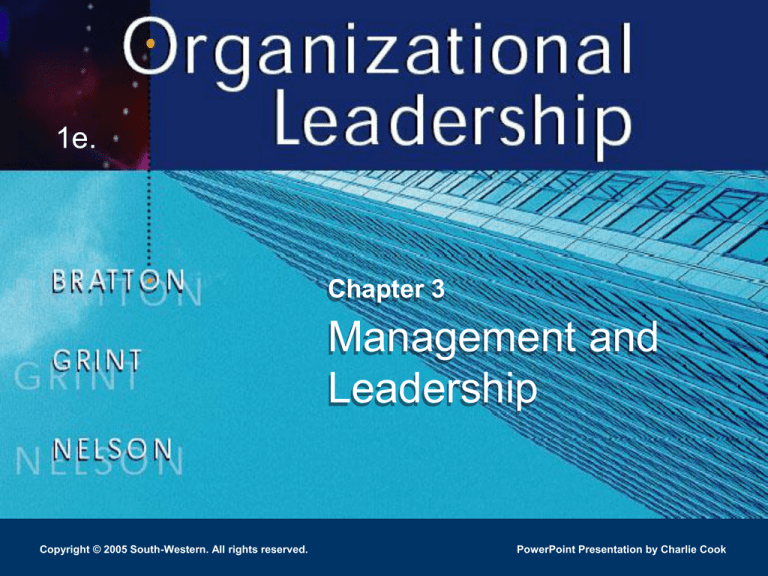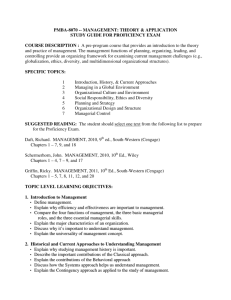
1e.
Chapter 3
Management and
Leadership
Copyright © 2005 South-Western. All rights reserved.
PowerPoint Presentation by Charlie Cook
Chapter Objectives
After completing this chapter, you should be able to:
Explain the competing perspectives on managerial
behavior—the science, political, control, and
practice perspectives.
Discuss the variations in managerial work due to
organizational strategy, structure, and environment.
Understand the significance of managerial work in
the leadership process.
Explain the practical implications of managerial
behavior research for managers.
Copyright © 2005 South-Western. All rights reserved.
3–2
Analyzing the Management Process
• If management is instrumental to organizational
performance, what do managers do?
Planning, organizing, directing, and controlling.
• If managerial behavior is contingent, what
affects what managers do?
Business strategy, organization, and external context
• If what managers do is processual, how do
managers do what they do?
Position, tasks, and power relations
Copyright © 2005 South-Western. All rights reserved.
3–3
Reflective Question ▼
• Based on your own work experience:
Which image of the manager do you think more
frequently represents reality—the professional
“technocrat,” engaged in strategic planning and
implementation, or the “reactive practitioner”
forced to “jump” to satisfy workplace
imperatives?
Explain your answer.
Copyright © 2005 South-Western. All rights reserved.
3–4
Managerial Theory
• Management (as a social group)
Individuals at a certain level in the hierarchy
responsible for bringing together and monitoring
resources and people in order to produce goods
and/or services.
• Management (as a social process)
The central process whereby work organizations
achieve the semblance of congruence and direction.
“Art, science, magic, and politics”
An organizational mechanism (process) designed to
coordinate and control productive activities.
Copyright © 2005 South-Western. All rights reserved.
3–5
The Four Major Perspectives on Management
Source: Based on Watson, T. (1986). Management, Organization and Employment Strategy. London:
Routledge; Reed, M. (1989). The Sociology of Management. London: Harvester Wheatsheaf.
Copyright © 2005 South-Western. All rights reserved.
Figure 3.1
3–6
Managerial Theory (cont’d)
• The Science Perspective
Focuses on a systems approach in the study of
formal structural configurations, the division of labor,
and systems in organizations.
Assumes that people can be trained to be effective
managers whose purpose is to create organizational
and work configurations for the realization of
organizational goals.
Copyright © 2005 South-Western. All rights reserved.
3–7
Managerial Theory (cont’d)
• The Political Perspective
Describes organizations as dynamic political systems
of power relationships that managers use (and
misuse) to influence others.
• The Control Perspective
Assumes that management activities are central to
the labor process in gaining control over and
cooperation and commitment from workers.
Copyright © 2005 South-Western. All rights reserved.
3–8
Managerial Theory (cont’d)
• The Practice Perspective
Conceptualizes management as activities intended to
integrate the diverse, complex, fragmented, and
contested practices in organizations.
Primary
social practices
– Transform resources into the production of goods and
services.
Secondary
social practices
– Achieve integration and coordination of primary social
practices through the design, implementation, and
monitoring of various administrative mechanisms.
Copyright © 2005 South-Western. All rights reserved.
3–9
Theoretical Perspectives on Management
Source: Based on Reed, M. (1989). The Sociology of Management. London: Harvester Wheatsheaf.
Copyright © 2005 South-Western. All rights reserved.
Table 3.1
3–10
Managerial Work: What Do Managers Do?
• Behavioral Approach
Observation of the activities and relationships that
comprise management roles.
Managerial work: characterized by brevity,
fragmentation, and variety.
• Management Roles:
Interpersonal, informational, and decision-making
Determined by:
Position in the organization’s hierarchy
Functional responsibility
Copyright © 2005 South-Western. All rights reserved.
3–11
The 10 Roles of a Manager
Source: Mintzberg, H. (1989). Mintzberg on Management. New York: Free Press, p. 16.
Copyright © 2005 South-Western. All rights reserved.
Figure 3.2
3–12
Managerial Work (cont’d)
• Managerial work reflects contextually specific
demands.
Task responsibilities (agenda building)
Setting
goals, allocating and stewarding scarce
resources, meeting production targets, and
identifying and solving problems, or “firefighting.”
Relationships (network building)
Obtaining
information, cooperation, and support
from other managers and motivating and
controlling subordinates.
Copyright © 2005 South-Western. All rights reserved.
3–13
Reflective Question ▼
• In their book Management Research,
Easterby-Smith, Thorpe, and Lowe (1991)
state that research on managers provides a
case in which the subjects are likely to be
more powerful than the researchers.
What implications does this observation have for
our understanding of management?
To what extent do studies of managers actually
describe managerial behavior?
Copyright © 2005 South-Western. All rights reserved.
3–14
View CD
• Go to the CD-ROM, and listen to Judy Wajcman’s
comments on researching women managers.
Begin by clicking on Approaches to Studying Leaders; then
choose the gender-influence button.
Wajcman’s commentary begins about six clicks into the
gender-influence menu.
• After listening to Wajcman, consider the following
question:
Why is it difficult to verify managers’ claims about what they
do?
Copyright © 2005 South-Western. All rights reserved.
3–15
Managerial Rationality: Why Do
Managers Do What They Do?
• Contingencies Affecting Managers
The external environment
Pressures and constraints
Competitive strategy
Organizational design
Technology
Power relationships
Cross-cultural factors
Copyright © 2005 South-Western. All rights reserved.
3–16
Theories of Managerial Rationality
Contingency
theory
Neoclassical
theory
Strategic
choice theory
Copyright © 2005 South-Western. All rights reserved.
Political
theory
Managerial
Rationality
Labor process
theory
3–17
Managerial Rationality (cont’d)
• The Neoclassical Approach
Posits that managers, as agents of owners and
investors, strive to maximize the efficiency and profits
of the firm by minimizing the cost of factor inputs.
• The Contingency Approach
Focuses on variations in organizational structures and
technical complexity that cause managers do what
structure and technology require of them.
Copyright © 2005 South-Western. All rights reserved.
3–18
The Relationship Between Technical Complexity
and Structural/Behavioral Characteristics
Source: Based on Woodward, J. (1965). Industrial Organizations: Theory and Practice. London: Oxford University Press.
Copyright © 2005 South-Western. All rights reserved.
Table 3.2
3–19
Managerial Rationality (cont’d)
• The Political Theory
Claims that managerial behavior is driven by the need
to respond to market demands and to internal
stakeholder groups to assure the continual availability
of resources.
• The Labor Process Theory
Argues that managers attempt to reduce dependency
on a group of workers by reducing required skill levels
such that those workers more easily replaceable
should they quit or withdraw their skills.
Copyright © 2005 South-Western. All rights reserved.
3–20
Managerial Rationality (cont’d)
• The Strategic Choice Theory
Stresses that management is a social process
whereby choices on various policies and activities are
made by a power-dominant group of leaders.
Recognizes that the chosen strategy affects the work
managers distribute or delegate to followers and the
time managers spend on supervision.
Implies that strategic choice dictates the human
resource strategy utilized in leader–follower
relationships.
Copyright © 2005 South-Western. All rights reserved.
3–21
Managerial Rationality (cont’d)
• Factors that limit the use of rationality by
managers:
Cognitive capacity
Time constraints
Imperfect information
Organizational politics
Strategic business decisions
Worker resistance
Managerial beliefs, values, and philosophies.
Copyright © 2005 South-Western. All rights reserved.
3–22
A Model of Management
• Managerial contingencies
External, organizational, and evaluative forces and
events, both outside and inside the organization, that
affect managerial behavior.
External context: economics, politics, society, and
technology
Organizational context: strategy, structure,
people, work, technology, culture, HRM, and
leadership activities
Managerial processes: technical, cognitive, and
interpersonal processes and skills, and
instructional skills
Copyright © 2005 South-Western. All rights reserved.
3–23
A Model of
Management
Source: Adapted from Squires,
G. (2001). “Management as a
Professional Discipline,” Journal
of Management Studies 34 (1),
pp. 473–487.
Figure 3.3
Copyright © 2005 South-Western. All rights reserved.
3–24
Behavior of Successful Managers
Source: Adapted from Kotter, J. (1982). The General Manager. New York: Free Press.
Copyright © 2005 South-Western. All rights reserved.
Figure 3.4
3–25
Reflective Question ▼
• Take another look at Figure 2.1.
Select one significant change in the external context,
and describe how the change impacts the managerial
behaviors shown in Figure 3.4.
How useful is this model for explaining the behavior of
successful managers and leaders in formal
organizations?
Copyright © 2005 South-Western. All rights reserved.
3–26
Implications of The Behavior-Success
Research
• Recognition of the frenetic nature of managerial
work will help managers better understand their
roles and their effectiveness.
• Managers need to develop a high level of
interpersonal as well as technical and cognitive
skills.
The relative importance of these skills depends on the
manager’s position in the authority hierarchy of the
organization.
Copyright © 2005 South-Western. All rights reserved.
3–27







